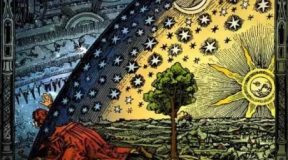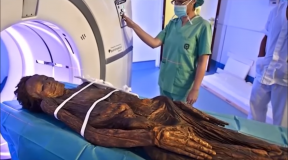
Our talk about the taxation of Egyptian farmers and the lack of taxation of temple lands sparked my interest. This got me thinking about the growing power, and eventual corruption, of the temples and priests that was mentioned. I did some research and found that the corruption spanned many rulers, all of which had some part in the increasing power of the temple and priesthood of Amen.
To start, Amen-Re was considered the true father of the pharaoh, which helped legitimize the power the pharaohs held over Egypt. The priests held a large amount of power with the general public, which they preserved by appearing as defenders and guardians of the oppressed people. The kings tried to limit the power of the priests of Amen to simply religious affairs. This was holding order until around 1498 BC, when Hatshepsut took control.
Hatshepsut was the only legitimate heir from the line of Amenhotep (his granddaughter, actually). To become king, her half-brother Thutmose II became her husband. When Thutmose II died, Hatshepsut took control; Thutmose III was still young and in the care of the priests of Amen (he was originally supposed to become a priest himself). As time passed, many chose sides. There were those who believed a woman could not be king and supported Thutmose III. Hatshepsut also had her supporters, the priests of Amen. To legitimize her claim to power, Hatshepsut had them declare her Pharaoh (the first woman to do this) and was from then on depicted with the masculine attributes of pharaohs. Her supporters reaped the rewards of her power; the First Prophet of Amen became the administrator of the temple’s wealth, head of all the gods’ priests in Upper and Lower Egypt, and prefect of Thebes and vizier. Hatshepsut also built the stunning temple Deirdre el Bahri, along with other smaller chapels. This is where we see the priesthood and temples gaining undue power.
While Hatshepsut was ruling Egypt, Thutmose III had become head of the army, and eventually took control back from his mother. His rule saw many conquests with much accompanying wealth. This wealth was first distributed to the warriors/soldiers, then the priesthood of Amen took their share, and in the end not much was left for Pharaoh. As their wealth and power increased, the power of the king decreased. The priests were now starting to push the king out of power, turn him into a figurehead and maybe try to get rid of the position all together. But still Thutmose III enlarged the temple’s landholdings and added to the Amen temple at Karnak.
A couple of pharaohs later (Amenhotep III) the worship of the red disc of the sun, Aten, gained popularity and followers. When Amenhotep III died, his son was brought up devoted to Aten, not Amen. As Pharaoh, Amenhotep IV’s name was changed to Ahkenaten and the funding to the temples of Amen subsequently stopped. The wealth, land, and slaves that belonged to the temples were most likely seized by the king. There was still a large public following of Amen, however, and the temples were eventually rebuilt by Ahkenaten’s son-in-law. The co-regent also returned all of the confiscated wealth to the priesthood.
This corruption of the priesthood of Amen was fostered by many pharaohs, and it certainly did not end with Ahkenaten’s son-in-law. While it appeared to come to a head in Hatshepsut’s time, the pharaohs before her are just as responsible. Or perhaps it was an inevitable occurrence, with the state religion being so closely tied with the power of the Pharaoh, and so adamantly followed by the people in many aspects of their daily lives.
http://www.reshafim.org.il/ad/egypt/priests_of_amen.htm
EDITOR’S NOTE: This and the last two articles I have posted are closely related, and some of the sources I will be using for my “gestalt” article that I said I would write in previous articles, about who the actual Israelites, Jews, and Aryans of antiquity really are. In the meantime I have a few decent videos on the Amen priesthood and Hyksos expulsion you can find in the video archive I will link below.
I also wanted to take a moment to inform EA readers that if you ever have a problem viewing videos here -I know some people in Europe are experiencing this due to being blocked by their ISP- use a VPN or web proxy and it should clear up any problem you are having.
They are very easy to use, just go to the URL of the web proxy of your choice and enter the address of the video/website you want to visit there in the text box provided. The website will fetch the page/video for you and “trick” your ISP into allowing it. Don’t worry it isn’t illegal, you are simply sending data to a site you are able to access and that website is fetching data it is allowed to access, but you aren’t, then sending that data back to you via their website, bypassing the block you receive by trying to directly access the site yourself. Be sure to use a US proxy server as nothing is blocked in the US. Personally I prefer proxysite.com, but you can do a web search for “web proxy” and choose whichever you prefer.
This link, for example, will allow you to visit this page via the web proxy. It works with any website so bookmark it for future use if you like. If you don’t need it yet, you likely will in the near future.
Exodus Decoded and the Search for the Real Mount Sinai
Planet Egypt – Temples of Power (Amenhotep IV. / Akhenaten)
Akhenaten and The Amarna Period
Akhenaten and Nefertiti Documentary
I also have numerous videos on the Hyksos and Phoenicians you can find in the archive, in the playlists, and with a simple search. Obviously I will add the disclaimer that I do not agree with 100% of the material in any video I ever endorse, but I didn’t make them, so that is always to be expected. I suggest comparing and contrasting the information they present with what you have learned here at Esoteric Awakening, and possibly other sources I hope, about the “hidden history,” to draw your own conclusions, and sometime in the near future I will publish my own analysis of all of this. What is important to note, in my opinion, is that all of this was happening at the same time, and has happened many times after (including today in real time). Namaste
This article was republished from anthropology.msu.edu








4 Comments
taylor
(May 23, 2021 - 5:04 am)This reminded me of an essay I wrote back in an ancient civilizations course I took, I hope you like it.
The Cult of Amun and the 3 Domains of Power: a Cultural Instance in the Emergence of States
The Ancient Egyptian New Kingdom, borne out of the removal of the once technologically superior Hyksos, ushered in a series of events that led to major variances in the location of wealth, politics and ideology. From a highly centralized and coherent state extorting its neighbors for profit under Thutmose III, to the chaos of religious heresy brought under Akhenaten, the doors to the fountains of power remained, at the very least, easy to pick open. Under the decline of the empire after Ramses II and III one group somehow birthed a dominant society-wide institution, a priesthood of the cult of Amun. The consolidation of economic, ideological and political power away from the pharaoh to this group is a prime example on how interplay between these 3 domains of power birth more complex civilizations through the inception of higher, more centralized institutions.
Narrow victory over the Sea peoples during Ramses III’s reign returned Egypt’s historic borders, cutting the Empires flow of trade and tribute from the Levant. What modern terms describe as recession was so that tomb robbing became rampant.1 A papyrus references the priests of the cult of Amun acquiring massive amounts of labour, land, capital and shipping over the course of the 20th dynasty.2 With the priesthood commanding the specialization of the factors of production, while the Pharonic state failed to secure more trade and commerce, the economic well being of Egypt made more sense under the cult than the crown. This swapping of economic clout severely diminished the pharaohs’ claim to power, and placed it into the hands of the Priesthood, who were already fast becoming the ideological and social powerhouse.
Following the Middle Kingdom, the Pharaoh served as the messenger of the gods to the people; to serve the pharaoh was to serve ‘the gods’. However, as shown from the written accounts of the 5 hymns to Amun-Ra3, the cult held the belief that everyone can be the messenger of the one mighty god, Amun-Ra. Indicative of wishes too not only herd the polytheists into one camp, but to remove the pharaoh as the godlike middle man. With the Pharaoh no longer the sole interpreter of the gods, and with the populace moving towards their single monotheistic god, the social and ideological power of the cult of Amun was growing significantly, using its traditional position in politics to its advantage.
Based on the nature of the evidence describing the Ramesside rulers after III appear to be ‘deficient in the energy and drive needed to maintain a strong central government’. 5 This conclusion seems substantial given their short time spans ruling, the poor building of monuments alongside the lost religious and economic prestige. It is no surprise that the Pharonic state degraded in its political capabilities. The last Ramesside ruler Rameses XI allowed Harihor, the High Priest of Amun to adorn royal regalia and conduct traditionally royal affairs, even while he himself was still on the throne.4 Such administrative changes failed to happen independently of military coercion. The coup by the priesthood gave incentive for Viceroy of Egyptian Nubia to launch a campaign against the cult of Amun at Thebes. He was ultimately defeated by Harihor4, who chased the Viceroy back into Nubia to control middle and Upper Egypt directly, with a family relative on the throne of Lower Egypt. Political power, in both its administrative and militaristic forms was transferred to the cult, completing the coup d’état of Egypt.
The Overthrow of the last dynasty of the New Kingdom and the beginning of 3rd intermediate period by the Cult of Amun at Thebes lends a prime example on how power in the 3 domains coalesces and then forges a newer society-wide institution. Firstly. a period of declining empire laid waste to trade and commerce. while the control of land, labour and capital and transportation monopolies of the cult grew, shifting economic power. Polytheism centered on the will of the pharaoh broke way to a monotheistic religion centered on the individual, having the effect of removing the Pharaoh’s religious duty and aggregating even more social power to the cult. All while recurrent weak leadership characterizing the Ramasside dynasties rulers after Ramses III weakened its ability to administrate and defend Egypt. The conquering of the Viceroy of Nubia and installation of a puppet pharaoh in the Delta cemented the power of the priesthood state. In todays climate where increasing amounts of wealth find its way into fewer and fewer groups of people, while rampant consumerism is encouraged in our mainstream ideological and cultural systems, and when governments continue to struggle at fulfilling their commitments to its people. The knowledge of how Egyptian power shifted during this time may bear some useful insights for the future of our civilization.
Reference (CSE style)
Sauneron S. 2000. The priests of ancient Egypt. Cornell University Press. pg .51-52.
Castle E. 1992 Shipping and Trade in Ramesside Egypt. Journal of the Economic and Social History of the Orient. 35(3):239-277. pg. 240
Thompson J. 2008. History of Egypt. from earliest times to the present. American University of Cairo Press. pg. 80
Torok L. 1997. The kingdom of Kush: Handbook of the Napatan-Meroitic Civilization. Brill Academic Publishers.
5.Lloyd A. 2014. Ancient Egypt: State and Society. Oxford Scholarship Online. pg.14
Bodhi Mantra
(June 12, 2021 - 9:36 pm)Bravo my friend, very nice, very insightful. Not only does the cycle repeat if we trace these bloodlines we can see it is the same people repeating it lol
Iraq factory services
(December 30, 2023 - 8:51 am)What i don’t understood is in reality how you’re now not really a lot more smartly-favored than you might be now. You’re very intelligent. You understand therefore significantly in terms of this topic, produced me personally believe it from a lot of numerous angles. Its like women and men are not interested except it is one thing to accomplish with Woman gaga! Your own stuffs outstanding. Always care for it up!
admin
(September 10, 2024 - 3:06 pm)Thank you my friend